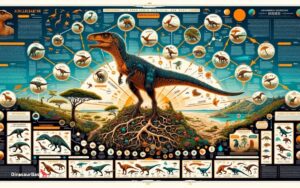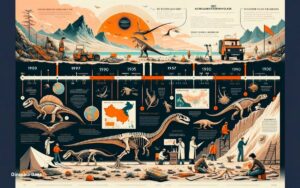Unearthing Achillobator: Fossil Site Techniques in Mongolia
Achillobator fossils in Mongolia are unearthed using meticulous excavation and mapping techniques. Expert paleontologists apply advanced technology and careful stratigraphic analysis.
Exploring the dusty, ancient landscapes of Mongolia, scientists unravel the secrets locked within its soil, discovering the remnants of the elusive Achillobator dinosaur. A formidable predator from the Late Cretaceous period, this dinosaur’s fossils serve as a goldmine for paleontologists seeking to understand prehistoric life.
Excavation teams navigate the Gobi Desert’s harsh conditions, armed with GPS units and digital mapping tools, ensuring precise fossil documentation. Their work begins with geological surveys, followed by the delicate process of exposing the bones, which sometimes involves chisels and dental picks for finer removal. Combining traditional techniques with modern technology, researchers meticulously preserve these prehistoric clues, piecing together the puzzle of Earth’s distant past. Engaging in this journey of discovery provides invaluable insights into the ancient ecosystems of Asia, illustrating the dynamic evolutionary history of dinosaurs.
The Achillobator Discovery
In the vast expanse of Mongolia’s Gobi Desert, an extraordinary dinosaur once roamed. The Achillobator, a fierce predator from the Late Cretaceous period, lay hidden beneath the sands until its remarkable discovery reshaped our understanding of dinosaur biodiversity. This post digs into the thrilling tale of this dinosaur’s unearthing and its profound impact on paleontology.
Initial Find In Mongolia
Mongolia’s rich fossil beds are a treasure trove for paleontologists. In 1999, an exploration team stumbled upon a set of bones that were unlike any they had seen before. The fossil find revealed the first signs of the Achillobator, initiating a flurry of excitement and meticulous excavation. The way the bones were spread suggested that the dinosaur was a nimble predator, possibly engaging in mid-hunt actions when it met its untimely demise.
The key steps in the discovery included:
- Surveying the potential fossil site for surface-level indications.
- Mapping out the bone distribution carefully.
- Systematic excavation to avoid damaging the fossils.
- Fine-cleaning and preparation in a lab setting.
Significance Of The Achillobator
The significance of the Achillobator rests in its unique anatomy and evolutionary connections. Its distinct features, such as the sickle-shaped claw on its foot, classify it as a dromaeosaurid. This group is closely related to modern birds. The discovery bolstered the theory that some dinosaurs had a shared lineage with our feathered friends. Achillobator was a significant find, adding a key piece to the puzzle of dinosaur lineage and survival adaptations.
- Bridging the gap between various dinosaur species.
- Insights into predatory behavior and physical characteristics.
- Enhanced understanding of dromaeosaurids and their environment.

Credit: en.wikipedia.org
Preparation And Planning
Before a single tool touches the earth, meticulous planning sets the stage for successful fossil excavation. The wind-swept expanses of Mongolia, where the Achillobator dinosaur remains hidden, demand a comprehensive approach from initial research to the final lift of the prehistoric treasure. Let’s explore the critical steps of preparation and planning for a fossil dig.
Research And Reconnaissance
Fossil hunting begins long before the first shovel breaks the ground. Extensive research helps narrow down potential sites. Teams pore over geological maps, scientific papers, and satellite imagery. Eyes sharp for clues, explorers survey the land. They look for signs of ancient life hidden beneath the surface.
- Studying historical fossil finds
- Analyzing rock formations
- Using technology to identify potential dig sites
Assembling The Team
Success hinges on a robust team dynamic. Specialists in paleontology, geology, and excavation come together, united by a passion for the past. With roles clearly defined, each team member prepares for the challenges ahead. Support staff, including cooks, medics, and drivers, complete the crew, ensuring that the mission runs smoothly from start to finish.
| Team Member | Specialization | Responsibility |
|---|---|---|
| Paleontologist | Dinosaur knowledge | Site identification |
| Geologist | Rock expertise | Stratigraphic analysis |
| Excavator | Fieldwork skills | Digging and retrieval |
Equipment lists are drafted. Supplies like GPS units, digging tools, and conservation materials are gathered. Finally, the team sets out, ready to unearth the secrets of the Achillobator in the heart of Mongolia’s vast, ancient landscapes.
The Excavation Process
The Excavation Process of dinosaur fossils like that of the Achillobator is a delicate and meticulous endeavor. It combines the thrill of discovery with the precision of scientific techniques. Each step is crucial to ensure these ancient treasures are carefully unearthed and preserved for study.
On-site Techniques
Digging up the past is no small task. The excavation team prepares the site with utmost care. They lay out a grid to record the location of each find accurately. Small tools, like brushes and dental picks, help to gently remove the surrounding rock. Experts use plaster to create supports around larger bones. This keeps them safe during transport.
- Grid Mapping – Ensures precise location documentation
- Gentle Tools – Protects fossils from damage
- Plaster Jackets – Stabilizes specimens for travel
Ensuring Preservation
Preserving fossils starts the moment they are spotted. Teams spray a special glue to strengthen the bones. They wrap small fossils in foil or tissue paper. This provides extra protection. Information tags go with each fossil. These tags tell us where and when the fossil was found.
| Material | Use |
|---|---|
| Glue | Strengthens Bones |
| Foil/Tissue | Protects Smaller Finds |
| Tags | Provides Vital Information |

Credit: www.researchgate.net
Challenges In The Field
Finding fossils in Mongolia presents unique challenges. Treacherous weather and demanding terrain test even the most seasoned paleontologists. Coordinating teams and supplies adds another layer of complexity to these already demanding expeditions.
Weather And Terrain
Exploring Mongolia’s fossil-rich lands requires resilience. The Gobi Desert, home to the impressive Achillobator dinosaur, is notorious for its extreme temperature swings and violent dust storms. Such conditions make every dig a battle against nature.
- Searing heat during the day can cause dehydration.
- Freezing nights demand quality sleeping gear.
- Dust storms may obscure visibility, complicating excavation.
Overcoming these hurdles is crucial for the success and safety of the team. The terrain, consisting of rocky outcrops and loose sands, further complicates transportation and accessibility to dig sites.
Logistical Obstacles
The logistics of conducting a dig in remote Mongolia are as challenging as the weather. Fossil sites are often miles from the nearest settlement.
- Transportation of heavy equipment to remote sites requires careful planning.
- Teams must carry enough supplies, from food to first aid, to last the duration of the expedition.
- Communication with the outside world is limited, making advance planning essential.
Securing permits and managing relations with local authorities also play a part in the logistical equation. The success of the excavation depends on overcoming these challenges.
Analyzing The Findings
After careful excavation, the Achillobator fossils from Mongolia advance to a new exciting phase: analysis. Scientists meticulously study each bone and fragment. This process sheds light on the dinosaur’s life millions of years ago. Now, we dive into how experts process this prehistoric data and what it reveals about dinosaur behavior.
Processing Fossil Data
The first step in understanding our ancient find involves processing the fossil data. Every piece is catalogued with precision:
- Identification – Assigning a label to each fragment
- Classification – Grouping similar fossils together
- Preservation – Using chemicals to strengthen the fossils
Fossils undergo CT scans and 3D modeling to reconstruct forms. This technology allows us to visualize the Achillobator as it once was.
New Insights Into Dinosaur Behavior
Analysis offers clues to behavior. For instance, tooth marks on bones suggest hunting patterns. The Achillobator’s limb structure hints at its movement and agility. Scientists compile this data to build a behavioral profile. They use this profile to understand:
- Diet and feeding habits
- Social interactions within species
- Defense mechanisms against predators
This information transforms our image of the Achillobator from mere fossils to dynamic creatures with complex behaviors.
Impact And Future Expeditions
The discovery of Achillobator in Mongolia has sparked immense interest in the field of paleontology. This excavation not only unearthed a new species of dinosaur but also opened doors to a deeper understanding of the prehistoric world. The impact of these findings and the anticipation of future expeditions continue to fuel scientific research and public imagination. Here, we discuss the foundational contributions to paleontology and the exciting prospects for further discoveries in Mongolia.
Contributions To Paleontology
With each layer of earth removed, the contribution of Achillobator to paleontology becomes clearer. This mighty dinosaur provides insight into the ecosystem dynamics and evolutionary biology of its time:
- Diversification of dinosaur species: Expands our knowledge of how these creatures adapted and thrived.
- Behavioral patterns: Offers clues to the hunting practices and social structure of predatory dinosaurs.
- Environmental understanding: Reveals details about the climate and geography during the Cretaceous Period.
Invaluable fossil records have allowed scientists to piece together a more accurate picture of the ancient world.
Prospects For Further Discoveries
Mongolia’s vast and varied landscape is a treasure trove of paleontological wealth. The prospects for future discoveries are promising:
| Area | Potential Finds |
|---|---|
| Gobi Desert | New dinosaur species, nest sites, and petrified woods |
| Nemegt Basin | Rare specimens of theropods and herbivores |
| Altai Mountains | Unique fossils due to high altitude and different preservation conditions |
Upcoming expeditions are poised to explore these areas with advanced technology and methodology. The anticipation for new finds continues to inspire both scientists and the public. These expeditions promise to bring a wealth of new data, enhancing our understanding of the prehistoric era.

Credit: gagebeasleyprehistoric.com
Frequently Asked Questions Of Unearthing Achillobator: Fossil Site Techniques In Mongolia
How Did Achillobator Hunt?
Achillobator likely hunted in packs, using speed and strength to ambush prey. Its sharp claws and teeth suggest it was an adept predator, tackling large dinosaurs and smaller animals.
What Is The New Dinosaur Discovered In Mongolia?
The newly discovered dinosaur in Mongolia is named Ajnabia odysseus. It’s a duck-billed dinosaur species uncovered in the Gobi Desert.
Why Are There So Many Fossils In Mongolia?
Mongolia boasts numerous fossils due to its vast, sediment-rich Gobi Desert, which effectively preserves dinosaur remains. Past geological events created ideal conditions for fossilization, making it a rich paleontological site.
How Fast Could Achillobator Run?
The exact speed of Achillobator is unknown, but as a dromaeosaurid, it could likely reach speeds similar to related species, estimated up to 30-40 mph.
Conclusion
Uncovering Achillobator remains is a testament to Mongolia’s rich prehistoric heritage. As paleontologists refine excavation protocols, further discoveries await. These insights not only deepen our understanding of the age of dinosaurs but also spotlight the inexhaustible potential of fossil studies.
Stay curious—tomorrow’s finds hinge on today’s tenacity and technique.




